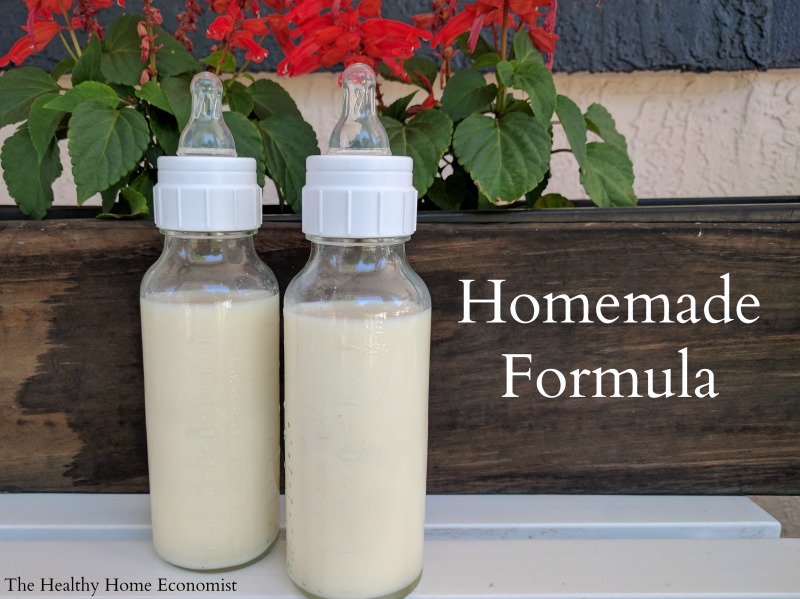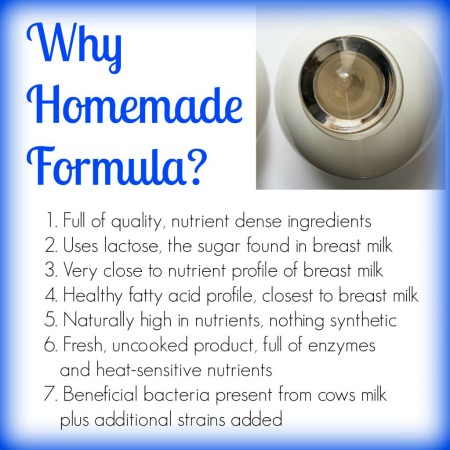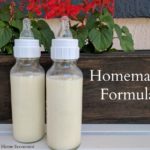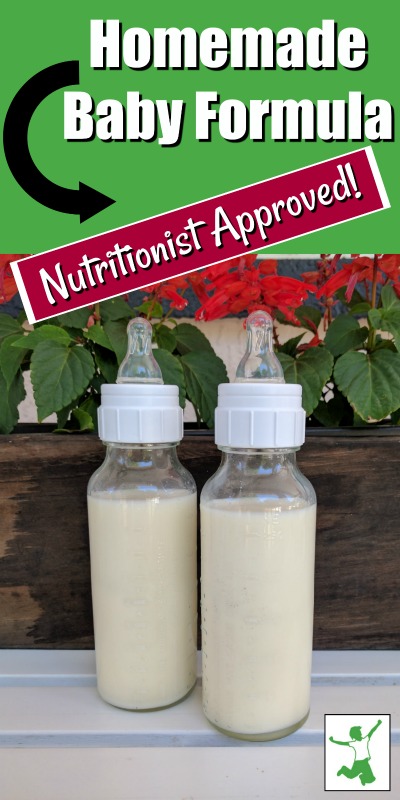Table of Contents[Hide][Show]
A nourishing homemade baby formula using safe, whole ingredients. This recipe was developed and tested by Dr. Mary Enig, a PhD Nutritionist and originally published in Nourishing Traditions cookbook in 1996. It was formulated to match breastmilk as closely as possible and is also suitable for infants. Source: Weston A. Price Foundation

There is no doubt that breastfeeding your baby is the best option for the child’s long-term health and development. Human breastmilk from a well-nourished mother is the perfect food for baby. However, in circumstances where the child is adopted or the Mother finds herself unable to breastfeed, formula feeding becomes necessary. In those cases, homemade baby formula is best.
Using a baby formula recipe that closely matches the nutritional profile of breastmilk is a far better choice than even organic baby formula from the health food store. More on this below.
Note: Donor programs are widely available for human breastmilk. But, the diets of the donor mothers are unknown and most likely nutritionally insufficient. In addition, breastmilk banks pasteurize the donated breastmilk which destroys much of the nutritional benefit. Unless you are fortunate to have a trusted and direct donor milk source in your community, avoid this option!
Dangers of Commercial Formula
Commercial formulas are always a poor choice for a number of reasons. First of all, formula manufacturers line the cans with the chemical BPA. This substance disrupts hormone development and is a probable contributor to early puberty in girls, and ADHD, urogenital abnormalities, and other ills in boys.
The European Food Safety Authority found that canned commercial formula is a significant source of BPA for infants, exposing the child to 13mcg of BPA per kg of body weight per day! BPA-free formula cans are no better. The chemical BPS is typically used instead which is just as dangerous.
Beware that manufacturers pack even organic commercial formula like Earth’s Best in BPA cans. Worse, they use organic brown rice syrup as the primary sweetener which is known to be frequently contaminated with arsenic.
In addition, all commercial milk formulas are processed at extremely high temperatures which violently denature the fragile milk proteins, render them allergenic, and add carcinogens to the final product. Soy infant formula is the worst. Obscenely high processing temperatures not only denature the proteins but large levels of phytic acid in soy block mineral absorption by the infant. Moreover, soy-based plant estrogens disrupt the hormonal development of the baby!
It seems that for the concerned Mother who is unable to breastfeed, learning how to make baby formula at home with safe, pure ingredients is the most prudent way to go!
Why Make Homemade Formula Even if You Are Breastfeeding
In the video below, I show you how to make your own safe, healthy raw milk homemade formula for your baby.
The recipe I follow was originally published in the cookbook Nourishing Traditions in 1996 and developed by Dr. Mary Enig.
Even though I breastfed each of my children for at least 2 years, I made this exact formula for my own children when I was away for the day or the evening as pumping was not an option that worked well for me.
I even used this homemade formula for an entire day once when I had some dental work done and was advised to pump and discard for 24 hours.
As a result, even successfully breastfeeding Moms can use this wonderful homemade formula as a supplement when necessary to their own nutrient-dense breastmilk!
It is advised that even breastfeeding Mothers have the ingredients for this formula on hand for an emergency. If Mom is sick or otherwise unable to nurse, Dad can step in and make this safe alternative until Mom is back on her feet. It takes a few days to a week to gather all the ingredients together to make this formula, which is why I advise having them on hand at all times.
Homemade Most Nutritious
The image below lists the reasons why it is worth it nutritionally to make formula yourself for your precious baby!
You can order all of the required ingredients for the homemade baby formula in one package from this reputable, vetted source.
Moms who have successfully used this formula feeding your children, please post about your experience in the comments section to encourage those who are considering it and need some Mom to Mom encouragement!

Where to Source Quality Milk
The most widely available grass-fed milk around the world is from cows. This is usually the most budget-friendly and easily sourced milk for this recipe for homemade formula.
If only goat milk is available in your area, this recipe for goat milk baby formula can be used instead. When using milk from ewes, please refer to the linked article for an adjusted recipe; one of the benefits of sheep milk is that it is higher in healthy fats than either goat or cow milk.
Camel milk formula is another option that is a particularly digestible form of dairy and growing in popularity around the world.
Alternatively, you can use low temp (vat) pasteurized, non-homogenized whole milk cultured with a piima or kefir starter. Then substitute the piima milk or kefir for the raw milk portion of the formula recipe. Cold-pressed raw milk also must be cultured before using it as it contains no probiotics.
Do NOT use ultrapasteurized (UHT) milk even if organic as it is too highly processed and extremely allergenic!
It is also best to avoid all types of powdered milk for this recipe. The factory process of making milk powder reduces nutrition considerably and denatures it, which makes it more likely baby will have an allergic reaction.
Dairy Allergy Option
If all types of dairy prove unsuitable for your baby, make this nondairy baby formula recipe instead. It uses a base of homemade bone broth as a substitute for milk. It is important not to utilize a plant-based or otherwise vegan baby formula recipe.
Avoid buying bone broth to make the dairy-free formula. Make it yourself! Manufacturers of commercial bone broth, even if authentic, may water down the end product. This is apparent if it does not gel when chilled in the refrigerator.
Many brands have toxic packaging issues as well. If you must buy it in a pinch, see my shopping guide page for vetted brands that are safe.

Homemade Baby Formula Recipe (for infants too)
A nourishing baby formula recipe you can make at home with safe, whole ingredients developed and tested by a PhD nutritionist to match breastmilk as closely as possible. Also suitable for infants.
Ingredients
- 2 cups raw cow milk OR organic whole milk yogurt
- 1 7/8 cups filtered water
- 1/4 cup liquid whey
- 4 Tbl lactose
- 1/4 tsp Bifidobacterium infantis powder
- 2-4 Tbl raw or pasteurized cream
- 1/2 tsp cod liver oil unflavored
- 1/4 tsp butter oil unflavored
- 1 tsp sunflower oil preferably organic
- 1 tsp extra virgin olive oil preferably organic
- 2 tsp virgin coconut oil preferably organic
- 2 tsp nutritional yeast
- 2 tsp gelatin
- 1/4 tsp acerola powder
Instructions
-
Fill a 2 cup Pyrex measuring cup with filtered water and remove 2 TBL (this will give you 1 7/8 cup water).
-
Pour about half the water into a pan and turn burner on medium.
-
Add the gelatin and lactose and let dissolve, stirring occasionally.
-
When gelatin and lactose are dissolved, remove pan from heat and add the rest of the water to cool.
-
Stir in the coconut oil and butter oil until melted.
-
Put remaining ingredients in a glass blender.
-
Add the water mixture and blend for about 3 seconds.
-
Place formula in glass baby bottles or a glass jar and refrigerate.
-
Before giving to baby, warm glass bottle in a pan of hot water or a bottle warmer. NEVER microwave baby bottles!
Recipe Video
Recipe Notes
If using raw cow milk from holstein cows, use 4 Tbl of extra cream (otherwise use 2 Tbl extra cream).
If choosing to make this homemade formula with camel milk, be sure to include 4 Tbl extra cream as camel milk is lower in cream than cow milk.
Do not use high oleic sunflower oil. Use only the brand recommended in the ingredients list which is cold pressed, organic, unrefined, and low oleic.
*Do NOT use powdered whey from the store as it is denatured. Avoid whey from making cheese as it will curdle the formula.
*Do not substitute pasteurized or powdered milk as these are heavily processed, denatured and allergenic foods.
*Do NOT use ultrapasteurized (UHT) cream. It is highly allergenic. Raw or pasteurized cream is acceptable.
*Do NOT use fish oil or krill oil instead of high vitamin cod liver oil as they do not contain any Vitamin D and very little to no Vitamin A.
Collagen powder may be substituted for the gelatin in a pinch (more on peptides in baby formula in this article).
If you are wondering where is the iron in homemade baby formula, this article provides an explanation.
If baby experiences constipation using this formula, try adding 1 tsp of molasses to each batch. This should help move things along.
How to Transition to DIY Formula
Once you’ve viewed the video, gathered the ingredients, and made your first batch, how do you feed it to your baby for the first time?
It is important not to switch all at once as this can cause gas, excessive spit-up, or an uncomfortable change in diaper habits such as constipation or overly loose stools.
Start by giving your baby three-quarters of the old formula blended with one-quarter of the homemade. Try this ratio for a day or two and see how your infant responds.
If no digestive upset or major change in diaper habits occurs, increase the amount to a 50-50 blend of old formula to homemade. Observe for another day or two as before.
If no major issues, increase once again to three-quarters homemade formula to one-quarter old formula. If baby does well on this blend for a third time, you are ready to fully transition to the homemade formula.
At any time during the transition, symptoms of intolerance emerge, back up to the previous successful blend ratio and stay there for a day or two before attempting to increase once again.
Homemade Formula FAQ
Weston Price Foundation
Feeding an Adopted Baby
Traveling Tips with Baby Formula Made at Home
Iron in Baby Formula
Collagen Peptides instead of Gelatin for Homemade Formula?










Hi Erica, one more thing. Do not substitute the sunflower oil. There is already extra virgin olive oil in the formula if you see the recipe again. The formula is necessary and your baby is not old enough to stop formula yet. She is only 8 months old .. she needs formula if you are not breastfeeding for another 4 months.
Hi Erica, a cold pressed traditional oil like sunflower is fine and absolutely critical to health in moderation. There is nothing wrong with omega 6 oils. If you try to avoid them entirely you will get ill with inflammation just like if you eat too many. The problem with omega 6 fats today is that Americans eat way too many and they are almost always rancid in processed foods. The ratio between omega 3 and omega 6 fats in the diet should be about 1:1 For most Americans the ration is 1:50 or more.
Hi Sarah,
Everything your doing is awesome & I sooo desperatly need it!…Anyway I was wondering about the sunflower oil; I was under the impression that it is a "yello oil" & bad for you. Is this not true? & if it is true can I substitute unrefined olive oil or eliminate the ingrediant all together since my baby is now 8months & I read (weston a price found.)that she can stop formula alltogether if she gets a well balenced (traditional)diet.
Thanks,
Erica
Hi Sarah,
I've been making this formula for my 6 mos old daughter since she was 4 mos old and she is the picture of health…rosy cheeks, vibrant, energetic and a good weight.
I had a lot of problems postpartum (55 hr labor, mastitis and fever for 5 days and surgery to remove leftover placenta/membrane tissue) and as a result I could not breastfeed past 9 wks. I was so devastated when I couldn't breastfeed that I had a nervous breakdown and was prescribed antidepressants to help me cope. For those women who are adamant that 'breast is best', in some cases it just isn't and no woman should be judged based on her physical limitations. Trust me, when a woman cannot breastfeed, it is very traumatic.
This homemade formula is the only thing that allowed me to make peace with my setbacks and I feel much better about things now that I see how much my baby is thriving. So a gentle reminder to all moms to be kind to other moms…support and don't judge. We all want the same thing…happy and healthy children.
Thanks Sara for sharing this recipe…I've long been a fan of Sally Fallon and I'm glad that you're doing such a great job of spreading great nutritional advice.
yes, you are right, it is very traumatic. i know exactly how you feel, in a similar situation. this formula, being whole and real foods, helps to alleviate my guilt over not being able to give my son all breast milk. i work my butt off to pump enough so that he can have some in every bottle with this formula.
Hi from Katie–I don't have any of the accounts to show who I am, so I'm "anonymous" — I'm a latecomer to this discussion, but have things to share.
My first baby was 7 months old when I got her. Foster care. I tried different types of formula, but although she seemed healthy, she still spit up a lot. Doctor put her on Nutramigen. No success. I finally looked at the ingredients. Corn syrup solids! I had already told the doctor that she was likely Native American, and prone to develop diabetes during her life. I still couldn't believe he put her on corn syrup! One night I ran out of formula, and in desperation, gave her some diluted milk from the fridge. She loved it, and didn't spit up at all! I threw out the formula. I didn't even know about raw milk back then.
I asked about the milk-after-one-year-old issue, and was told that cow milk is high in sodium, and the baby's system (kidneys?) can't handle it. Formula has had the sodium removed.
My son was born when she was 17 months old, and I had a hard time with breastfeeding, but stayed with it. My milk never really did 'come in.' My dad called my milk 'Blue John,' meaning it was white with a blue-tint and almost zero cream. I honestly can't remember how healthy my diet was, but I was really stressed out. When he had his first immunizations (late) at about three months old, he was sick for a week. Kept nothing down. Finally got back into nursing. We quit once more when I was sick on antibiotics, but resumed until he was 17 months old — he bit me, and wouldn't stop! My son is small boned, thin, and knock-kneed, but he could tell you any phonetic sound in the alphabet when he was 22 months old. He is almost 3.5 now, and academically on a kindergarten-first grade level. I don't even 'teach' him. (But I would never brag)
When he was nearly two months old, I was asked to take a newborn until his adoption paperwork could finish processing. I offered to nurse him, but was kindly told not to. Thankfully, this was a very healthy baby when he was born.
Later I was asked to take an 8 weeks premature infant home–I already had one of her siblings. First thing I did was call everyone I knew who might have breast milk on hand. One mom had some in the freezer (turns out it was sour, and she wouldn't take it), and another had weaned her son two days before. The latter agreed to keep pumping as long as possible, and gave me what she had in the freezer. Of course, I couldn't tell children's services. I wish I had known about this formula then. The baby spit up, had sinus problems, temperature problems, and still had to be fed at least every three hours round the clock during the two months we had her. I tried babywearing with her, but it was just too hot.
Now I'm rambling, but thanks for sharing all this information. Maybe I can pass it on to someone who needs it.
I've been feeding my baby this homemade formula since he was 5 months old. He got sick when he was 4 months old and as a result of him not eating as much, my supply went down. I tried pumping and all other suggestions to try and get my supply back to where it was but I think the stress just kept me from succeeding. I have a very healthy 1 yr old right now. I read all the comments and I'm not sure what the argument is about? Sarah is not promoting that you should feed this homemade formula over breast milk but to use as an alternative to using the commercial crap that is sold in the store. As for the donated milk…unless I knew the donor personally, I would be leery of it also. I definitely wouldn't want to feed my baby pasteurized milk whether it is breast milk or cow milk and how do you know what the donor is exposed to in her environment? I don't think anyone here is arguing that formula is better than breast milk but if you can't breastfeed your baby for what ever reason, this is definitely a great alternative. Thanks Sarah for bringing this to the attention of so many people. I have several friends that read your blog that aren't WAPF. I wish I knew about this when I had my first child.
Hi Sarah, I can't click my own ads to get the URL to block. Please email me what they are and I am happy to block them.
I thought you might be interested to know that Google is showing ads for baby formula on this page. I think you can block ads selectively.
Found you on Pennywise Platter. Thanks for sharing this. I breast feed but I'm interested in trying this when I need to supplement.
I am so glad you posted this. . .thanks for sharing, another good information!